Harvest Cooking
Air Date: Week of September 28, 2007
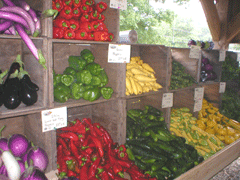
Red Fire Farm's local produce at market. (Photo: Red Fire Farm)
The harvest season is winding down and people's pantries are filling up with the last of the summer's tomatoes, winter squash, carrots and cobs of corn. In this final segment of our series on cooking with CSAs, producer Ian Gray visits his local farm in Granby, Massachusetts with food writer Kathy Gunst for some tips on how to make the produce last through the winter months.
Transcript
GELLERMAN: Well, it’s that time of year again. The harvest season is winding down and people are gearing up for winter, stocking their pantries with the last picks of the season—tomatoes, squash, carrots and cobs of corn. The culinary challenge: to make the fresh, locally grown summer produce last through the long, cold months ahead.
Living on Earth producer Ian Gray has been watching this year’s harvest. He’s a member of a CSA, a Community Supported Agriculture at Red Fire Farm, where every week he gets his share of the farm’s bounty. Food writer Kathy Gunst has been joining Ian as he collects his produce and showing him creative ways to cook it. In the final installment of our series, Ian and Kathy traveled to Granby, Massachusetts where they met Red Fire Farm’s Ryan Voiland.
[SOUNDS OF WALKING OUTDOORS]
GUNST: Could you tell us a little bit about Red Fire Farm? How long has this land been farmed and . . . ?
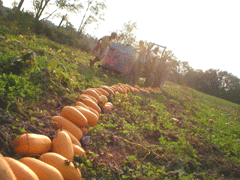
(Courtesy of Red Fire Farm)
GUNST: I can’t help but notice this is a fairly suburban neighborhood and here you have this sort of bucolic rural farm next to house, house, house. Have you really saved a big track of land I would think?
VOILAND: That’s true. I think the situation with the land here is typical of much of New England in that we have suburbanization encroaching from all directions and farmland is the easiest land to develop for developers who want to build houses. Usually farmland is well drained so it’s easy to put in a septic system. I think it’s really a tragedy and pretty shortsighted for planners, that we allow all of our good farmland to get carved up.
GUNST: So now that you’re winding down the seventh growing season—how is it going? How’s the CSA? I mean, are you on target?
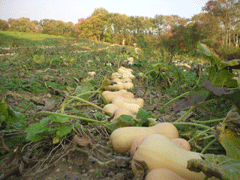
(Courtesy of Red Fire Farm)
GUNST: Tell us again how many families you’re feeding through the CSA.
VOILAND: The CSA is, we sell about 500 shares. Some of those shares go to families- are split between-, people use them in different ways.
GUNST: Five hundred families is really impressive.
VOILAND: It’s quite a bit of food. It’s definitely quite a bit of food.
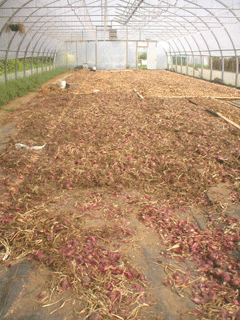
Radishes at Red Fire Farm (Courtesy of Red Fire Farm)
VOILAND: We’re at the farmhouse where much of the farm crew lives, including myself. And we’re going to let you use the kitchen and cook something up with the produce that we collected.
[MUSIC: Beastie Boys “Sabrosa” (Sounds of Science—2000)]
GRAY: Alright, now to work, right?
GUNST: I mean this is just a joy because these are such gorgeous vegetables. What I’ve discovered is that you can make just a fabulous sauce, in this case a tomato sauce, using all of his onions and garlic and herbs from the garden and you can roast it at a really high temperature. There’s no peeling. There’s no seeding. No fuss no muss.
[MUSIC: Beastie Boys “Sabrosa” (Sounds of Science—2000)]
GUNST: We’re going to take all of these different tomatoes. We have the Brandywine, the Germans, the yellows, the green stripe and we’re just going to chop them up. We’re going to take the core out. And you want to just chop the tomatoes up into I don’t know—one-inch pieces—but again, it doesn’t matter because the high heat’s going to break it down. I’ve got a big roasting pan. Anything you’ve got you can use; ovenproof skillets. The other great thing about this sauce is you can make this with three tomatoes. You can just make up a bunch of sauces.

Red Fire Farm's local produce at market
(Courtesy of Red Fire Farm)
GUNST: Exactly. You can just pop it into a bowl and keep it in the refrigerator or you can stick it in a plastic bag and put it in your freezer.
GRAY: So, I’m looking at a lot of these tomatoes that we picked. They’re actually kind of cracked and a little bit gnarled on the top and they’re black and bruised a little bit. They’re not the best tomatoes from the field.
GUNST: But when you cut the tomato open look at the inside. I mean it’s perfect. It’s juicy. I mean the flesh is just gorgeous. So don’t worry. Looks can be deceptive.
GRAY: We’ve got our tomatoes finished up here so you’re going to start in on onions in a second.
GUNST: Oh, I’d say we have about; oh I’d say eight pounds of tomatoes in there. And now I’m going to take an onion and again—just coarsely chop. It doesn’t have to be precise.
[CHOPPING SOUNDS]
GUNST: Okay. And we’re going to onion and garlic and some fresh herbs. I’m just going to sprinkle the onions on top of the tomatoes. We’re going to drizzle it with a little bit of olive oil. And decent olive oil would really pay off here. We just want to lightly coat it, maybe about a quarter of a cup. Again, it depends on how much sauce you’re making. Some salt and pepper. And then we picked a beautiful head of basil. We’ll add some of that chopped up. A little salt and pepper, give it a stir. It looks like gazpacho. Look at this, it’s a beautiful tomato salad or soup at this point. Okay we’re going to pop that into our 450-degree oven and we’re not going to touch it.
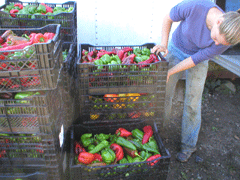
(Courtesy of Red Fire Farm)
GUNST: Alrighty, it has been about an hour and ten minutes and our sauce has thickened up just a bit.
GRAY: And the smells are just flying out of this oven. Oh my.
GUNST: So, we’re going to take this out of the oven and we have got roasted tomato sauce. Let’s turn that oven off. And what we’re going to do is taste it for seasoning. We’re going to adjust with salt and pepper. You could add some chili flakes or tobacco sauce to give it a little bit of a kick. And then we’re going to let it cool.
GRAY: Great. Well, I can’t wait to put this away and then forget about it for a while and then . . .
GUNST: Well, you could have a little of it tonight. But really the real treat of this is that you haven’t spent an entire weekend canning but you still have all the flavors of the harvest waiting for you all winter long.
[MUSIC: Beastie Boys “Sabrosa” (Sounds of Science—2000)]
GELLERMAN: Food writer Kathy Gunst’s latest book is “Stonewall Kitchen Favorites.”
To get the recipe for quick roasted tomato sauce, check out our website, loe dot org. Our local farm cooking segment was produced by Ian Gray.
Links
Living on Earth wants to hear from you!
Living on Earth
62 Calef Highway, Suite 212
Lee, NH 03861
Telephone: 617-287-4121
E-mail: comments@loe.org
Newsletter [Click here]
Donate to Living on Earth!
Living on Earth is an independent media program and relies entirely on contributions from listeners and institutions supporting public service. Please donate now to preserve an independent environmental voice.
NewsletterLiving on Earth offers a weekly delivery of the show's rundown to your mailbox. Sign up for our newsletter today!
 Sailors For The Sea: Be the change you want to sea.
Sailors For The Sea: Be the change you want to sea.
 The Grantham Foundation for the Protection of the Environment: Committed to protecting and improving the health of the global environment.
The Grantham Foundation for the Protection of the Environment: Committed to protecting and improving the health of the global environment.
 Contribute to Living on Earth and receive, as our gift to you, an archival print of one of Mark Seth Lender's extraordinary wildlife photographs. Follow the link to see Mark's current collection of photographs.
Contribute to Living on Earth and receive, as our gift to you, an archival print of one of Mark Seth Lender's extraordinary wildlife photographs. Follow the link to see Mark's current collection of photographs.
 Buy a signed copy of Mark Seth Lender's book Smeagull the Seagull & support Living on Earth
Buy a signed copy of Mark Seth Lender's book Smeagull the Seagull & support Living on Earth

